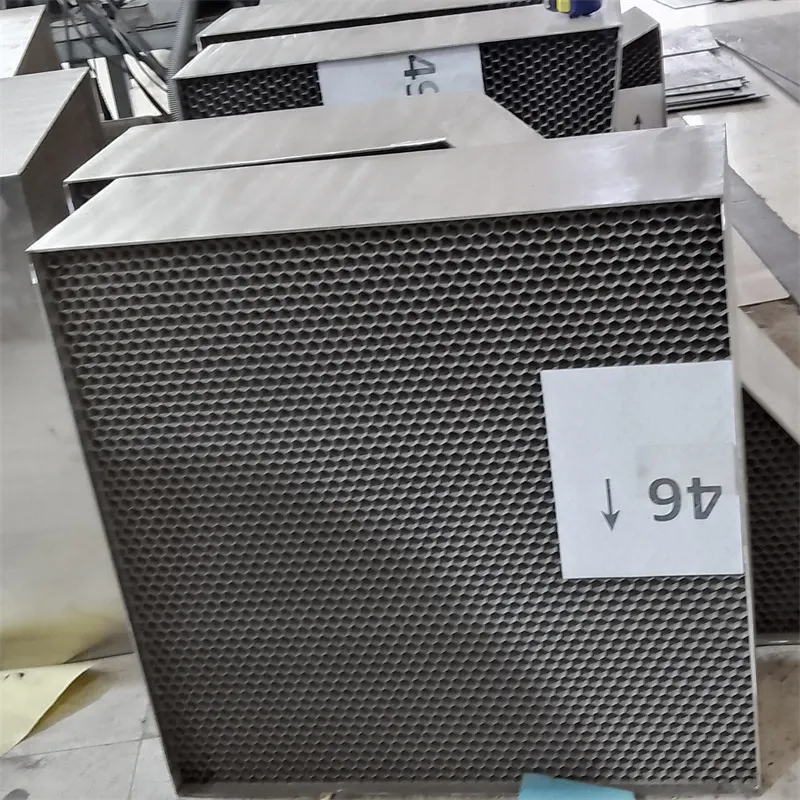
- Afrikaans
- Albanian
- Amharic
- Arabic
- Armenian
- Azerbaijani
- Basque
- Belarusian
- Bengali
- Bosnian
- Bulgarian
- Catalan
- Cebuano
- China
- China (Taiwan)
- Corsican
- Croatian
- Czech
- Danish
- Dutch
- English
- Esperanto
- Estonian
- Finnish
- French
- Frisian
- Galician
- Georgian
- German
- Greek
- Gujarati
- Haitian Creole
- hausa
- hawaiian
- Hebrew
- Hindi
- Miao
- Indonesian
- Italian
- Japanese
- Javanese
- Malay
- Persian
- Portuguese
- Punjabi
- Russian
- Spanish
- Swahili
- Telugu
- Vietnamese

Jan . 22, 2025 04:55
Back to list
Aluminium Emc Shielded Honeycomb Vent For 120*120mm Fan
In the world of advanced engineering and industrial applications, honeycomb vents have emerged as an indispensable component. These structures, characterized by their unique hexagonal lattice, are not simply a marvel of geometric elegance but serve numerous practical purposes across various domains. Here we delve into the fascinating realm of honeycomb vents, exploring their use, benefits, and the scientific principles that make them irreplaceable.
Precision is key when manufacturing honeycomb vents, as even slight deviations can affect their performance. Advanced manufacturing techniques, such as 3D printing and material science innovations, have enabled the production of perfectly uniform honeycomb structures. These technological advancements ensure that each vent fulfills its intended function with maximum efficiency, whether it's filtering air or supporting a lightweight structure. In environments exposed to electromagnetic interference (EMI), honeycomb vents offer a unique solution. By integrating conductive materials within the lattice structure, these vents can effectively shield sensitive electronic equipment from unwanted electromagnetic noise. This capability is becoming increasingly important as the proliferation of electronic devices necessitates robust protection against interference, ensuring reliable operation in various settings, from industrial floors to military applications. The versatility of honeycomb vents is matched by their environmental benefits. Modern production processes focus on sustainability, using recyclable materials and energy-efficient methods to craft these components. By choosing honeycomb vents, industries can contribute to a lower environmental footprint while reaping the benefits of efficient, high-performance products. In conclusion, honeycomb vents exemplify the intersection of nature-inspired design and cutting-edge technology. Their widespread application across multiple industries highlights their indispensable role in modern engineering solutions. As technology advances, the demand for efficient, reliable, and sustainable components will continue to grow, solidifying honeycomb vents' status as a foundational element in innovative design and engineering.


Precision is key when manufacturing honeycomb vents, as even slight deviations can affect their performance. Advanced manufacturing techniques, such as 3D printing and material science innovations, have enabled the production of perfectly uniform honeycomb structures. These technological advancements ensure that each vent fulfills its intended function with maximum efficiency, whether it's filtering air or supporting a lightweight structure. In environments exposed to electromagnetic interference (EMI), honeycomb vents offer a unique solution. By integrating conductive materials within the lattice structure, these vents can effectively shield sensitive electronic equipment from unwanted electromagnetic noise. This capability is becoming increasingly important as the proliferation of electronic devices necessitates robust protection against interference, ensuring reliable operation in various settings, from industrial floors to military applications. The versatility of honeycomb vents is matched by their environmental benefits. Modern production processes focus on sustainability, using recyclable materials and energy-efficient methods to craft these components. By choosing honeycomb vents, industries can contribute to a lower environmental footprint while reaping the benefits of efficient, high-performance products. In conclusion, honeycomb vents exemplify the intersection of nature-inspired design and cutting-edge technology. Their widespread application across multiple industries highlights their indispensable role in modern engineering solutions. As technology advances, the demand for efficient, reliable, and sustainable components will continue to grow, solidifying honeycomb vents' status as a foundational element in innovative design and engineering.
Products categories
Latest news
-
Why Vented Aluminum Honeycomb Is Leading the Way in Shielding and Ventilation SolutionsNewsJul.18,2025
-
Why Stainless Steel Honeycomb Panel is the Ultimate Choice for High-Tech Shielding and ProtectionNewsJul.18,2025
-
Why Honeycomb Strips Are Revolutionizing High-Speed Sealing SolutionsNewsJul.18,2025
-
Shielded Glass Innovation Powers the Future of Electromagnetic ProtectionNewsJul.18,2025
-
Precision Starts Here: Revolutionizing Airflow Control with Honeycomb Wind Tunnel SolutionsNewsJul.18,2025
-
Elevate Industrial Performance with Precision-Engineered Steel Honeycomb Core SolutionsNewsJul.18,2025
-
Vented Aluminum Honeycomb: A Smart Shield for Airflow and EMI ControlNewsJul.11,2025















